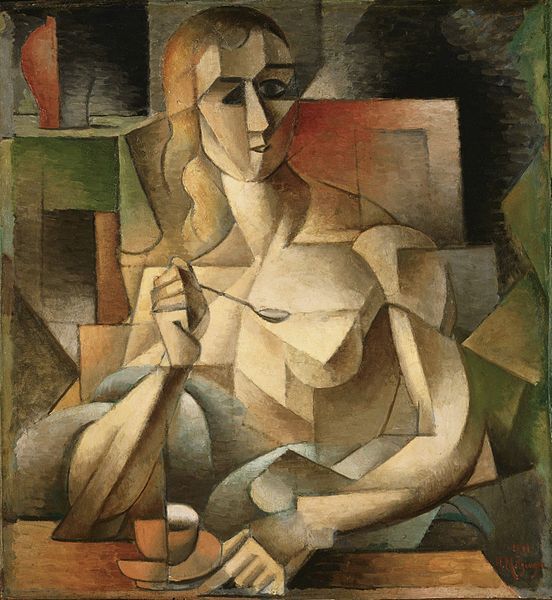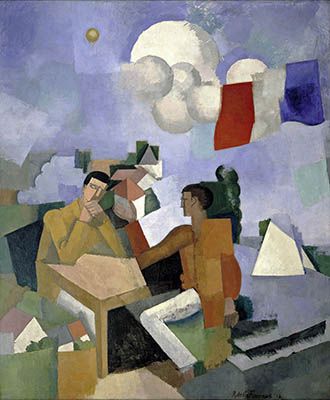Cubism is an early-20th-century avant-garde art movement that revolutionized
European painting and sculpture, and inspired related movements in music,
literature and architecture. Cubism has been considered the most influential art
movement of the 20th century.The term is broadly used in association with a
wide variety of art produced in Paris (Montmartre and Montparnasse) or near
Paris (Puteaux) during the 1910s and throughout the 1920s. The movement was
pioneered by Pablo Picasso and Georges Braque, joined by Jean Metzinger,
Albert Gleizes, Robert Delaunay, Henri Le Fauconnier, and Fernand Léger.
One primary influence that led to Cubism was the representation of
three-dimensional form in the late works of Paul Cézanne. A retrospective of
Cézanne's paintings had been held at the Salon d'Automne of 1904, current
works were displayed at the 1905 and 1906 Salon d'Automne, followed by two
commemorative retrospectives after his death in 1907. In Cubist artwork,
objects are analyzed, broken up and reassembled in an abstracted form—instead
of depicting objects from a single viewpoint, the artist depicts the subject from
a multitude of viewpoints to represent the subject in a greater context.
In France,offshoots of Cubism developed, including Orphism, Abstract art and
later Purism. The impact of Cubism was far-reaching and wide-ranging.
In France and other countries Futurism, Suprematism, Dada, Constructivism,
Vorticism, De Stijl and Art Deco developed in response to Cubism. Early
Futurist paintings hold in common with Cubism the fusing of the past and the
present, the representation of different views of the subject pictured at the same
time, also called multiple perspective, simultaneity or multiplicity, while
Constructivism was influenced by Picasso's technique of constructing sculpture
from separate elements. Other common threads between these disparate
movements include the faceting or simplification of geometric forms, and the
association of mechanization and modern life.
Les Demoiselles d'Avignon
(Pablo Picasso)

Oil on canvas - Museum of Modern Art, New York
Picasso's painting was shocking even to his closest artist friends both for its content and for
its formal experimentation. The subject matter of nude women was not in itself unusual, but
the fact that Picasso painted the women as prostitutes in aggressively sexual postures was
novel. Their blatant sexuality was heightened by Picasso's influence from non-Western art
that is most evident in the faces of three of the women, which are rendered as mask-like,
suggesting that their sexuality is not just aggressive, but also primitive. The unusual
formal elements of the painting were also part of its shock value. Picasso abandoned the
Renaissance illusion of three-dimensionality, instead presenting a radically flattened
picture plane that is broken up into geometric shards. For instance, the body of the standing
woman in the center is composed of angles and sharp edges. Both the cloth wrapped around
her lower body and her body itself are given the same amount of attention as the negative
space around them as if all are in the foreground and all are equally important.
The painting was widely thought to be immoral when it was finally exhibited in public
in 1916. Braque is one of the few artists who studied it intently in 1907, leading directly to
his later collaboration with Picasso. Because it predicted some of the characteristics of
Cubism, Les Demoiselles is considered proto or pre-Cubist.
Tea Time
(Jean Metzinger)

When this painting was shown at the 1911 Salon d'Automne, the critic Andre Salmon
dubbed it "The Mona Lisa of Cubism." While Picasso and Braque were dematerializing
figures and objects in their works, Metzinger remained committed to legibility, reconciling
modernity with classicism, thus Salmon's nickname for the work. Despite the realism of the
painting, like other Cubists, Metzinger abandons the single point of view in use since the
Renaissance. The female figure and the still life elements are shown from differing angles as
if the artist had physically moved around the subject to capture it from different points of
view at successive moments in time. The teacup is shown in both profile and from above,
while the figure of the centrally positioned woman is shown both straight on and in profile.
The painting was reproduced in Metzinger and Gleizes's book Du Cubisme (1912) and in
Apollinaire's The Cubist Painters (1913). The work became better known at the time than
any work by Picasso or Braque who had removed themselves from the public by not
exhibiting at the Salon. For most people in the 1910s, Cubism was associated with artists
like Metzinger, rather than its originators Picasso or Braque.
Conquest of the Air
( De La Fresnaye)

La Fresnaye's colorful and optimistic paintings did much to popularize Cubism before
World War I. In The Conquest of Air, his most famous work, he depicts himself with his
brother Henri, sitting at a table outdoors. The yellow hot-air balloon in the distant
background likely refers to the oldest balloon race in the world, the Gordon Bennett cup,
which took place annually from 1906 to 1938, with breaks during the war years. The race
alternated between European cities, but was held first in Paris in 1906 and again in 1913.
A French crew won the race in 1912, adding to their national honor in this arena as the
French had invented the hot-air balloon in 1783, no doubt explaining the celebratory French
flag in the painting. La Fresnaye's work shows influence from both traditional Cubism in its
use of geometrical forms and also from Delaunay's Orphism in its bright color and use of the
circle. He was a member of La Section d'Or Cubists from 1912-1914, but after the war
became a well-known proponent of more traditional realism.